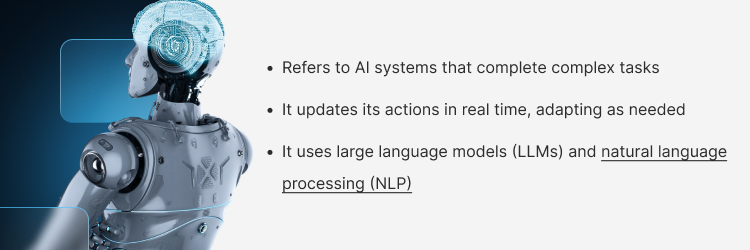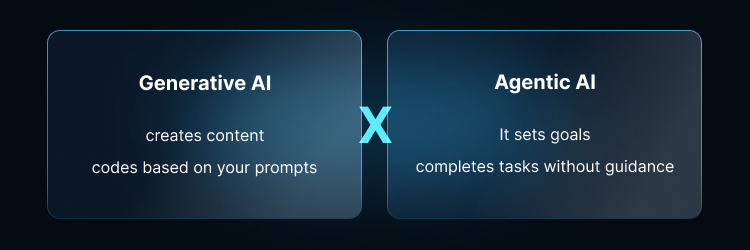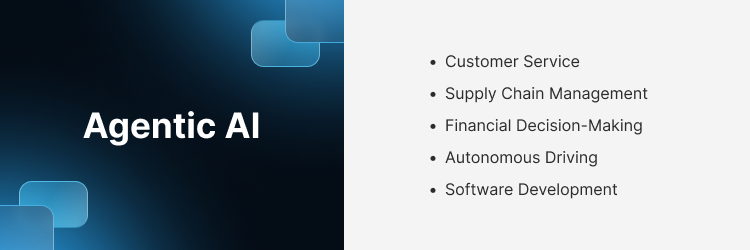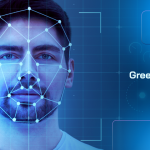
Agentic AI is a new kind of artificial intelligence. These AI systems plan, act, and adapt without constant human input. Built around autonomous agents, they handle complex tasks from start to finish.
Unlike traditional AI, which reacts to direct prompts, agentic AI takes initiative. It can plan, decide, and adjust based on changing data. It’s also more capable than generative AI, which only produces content based on instructions.
In this guide, we’ll explain what agentic AI is, how it works, where it’s used, its benefits, and the challenges it brings.
What Is Agentic AI?

Agentic AI refers to AI systems that complete complex tasks with little human help. These systems plan steps, solve problems, and make decisions on their own.
You can give it a goal, like “plan a trip,” and it will handle the rest—flights, hotels, and itinerary—without micromanaging.
This AI runs across multiple stages. It updates its actions in real time, adapting as needed. That’s a major shift from reactive AI, which only responds to prompts.
It uses large language models (LLMs) and natural language processing (NLP) to understand intent and context, which is how it operates smoothly, even in changing or unfamiliar settings.
Agentic systems also work in teams. Different AI agents handle different tasks, collaborating to reach the goal more efficiently.
AutoGPT is one example. When given a task like “research competitors,” it does everything—from gathering information to summarizing results—without follow-up commands.
How Agentic AI Works
Agentic AI is made of self-directed agents. Each agent observes, plans, and acts independently. It uses machine learning and predictive models to manage tasks without supervision.
Let’s break down how these AI systems operate:
Core Component of Agentic AI
- Perception Module: The agent observes its surroundings using APIs, sensors, or system inputs. It uses LLMs and NLP to understand the situation.
- Knowledge Representation: It turns raw input into structured data that the system can reason about. This makes sense of complex or unorganized information.
- Reasoning, Planning, and Decision-Making: The AI reviews goals, analyzes the situation, and builds a plan. It chooses actions using logic, memory, and prediction models.
- Action Module: The AI executes tasks like writing code or sending alerts. Every action follows its plan and is updated as new data arrives.
- Feedback Loop: The AI watches how its actions play out. If needed, it adjusts its plan to stay on course.
- Continuous Learning: Agentic AI improves over time. It learns from success and failure. With each task, it gets better at solving problems.
How Agentic AI Reaches Its Objectives
- Goal Definition: You set goals like “fix this bug” or “optimize workflow.”
- Environment Analysis: The AI collects user input, system states, or resource info.
- Strategy Formation: It breaks the goal into smaller tasks and picks the best path forward.
- Autonomous Execution: The AI acts. It can run scripts, access APIs, or collaborate with other agents.
- Self-Improvement: As it works, it tracks what works best. It updates its strategy for next time.
Single-Agent vs Multi-Agent AI Systems
A single-agent system uses one AI agent to complete a task. It works best for simple goals like sending auto-replies or managing personal schedules.
A multi-agent system uses several agents working together. Each handles a part of the task. They communicate, coordinate, and adjust in real time to reach shared goals.
Multi-agent setups are ideal for complex tasks like managing traffic, controlling fleets, or running financial systems. The agents interact to optimize performance and adapt to changing environments.
Use single-agent systems for precise, low-complexity objectives. Choose multi-agent setups when tasks need scale, speed, or cooperation across different systems.
Quick Comparison: Single vs Multi-Agent AI
| Feature | Single-Agent System | Multi-Agent System |
| Number of Agents | One | Two or more |
| Environment | Treated as static or predictable | Dynamic, changes due to other agents’ actions |
| Communication | Not needed | Often essential (messages, signals, coordination protocols) |
| Decision-Making | Centralized (within the agent) | Distributed among agents |
| Use Cases | Self-driving car on empty roads, personal finance bots | Warehouse robots, drone fleets, multiplayer game AIs |
| Complexity | Simpler and more straightforward to design | Higher complexity due to agent interactions |
| Goal Alignment | One agent with a clear goal | Agents may share, align, or conflict in goals |
Agentic AI vs Generative AI: Key Differences

Generative AI creates content. It writes, designs, or codes based on your prompts. It supports creativity but always waits for input.
Agentic AI acts. It sets goals, plans steps, and completes tasks without guidance. It works on its own from start to finish.
Here’s how they compare:
Generative AI
- Creates content (text, images, code)
- Needs user input to begin
- Focused on creativity and support
Agentic AI
- Solves problems through actions
- Works independently toward goals
- Manages entire processes from end to end
Example: Generative AI suggests how to fix code. Agentic AI finds the bug, fixes it, and tests it—all on its own.
What Makes Agentic AI Different from Traditional AI?
Traditional AI follows rules, responds to prompts, and needs humans to guide every step. It struggles with context or changing goals.
Agentic AI thinks for itself. It understands the situation, sets steps, and adjusts as needed. It doesn’t wait for commands or rely on static rules.
This autonomy helps agentic systems solve complex problems, even when conditions change or data is incomplete.
How Agentic AI Agents Learn and Improve
AI agents learn by experience. They test what works, adjust what doesn’t, and improve with every task.
For example, a support bot learns which replies solve issues faster. It keeps using the best ones to improve response times.
Agents also learn by spotting patterns. In supply chains, for example, an agent might notice delays linked to specific vendors and adjust plans to avoid them.
They rely on feedback loops. Each outcome is analyzed, and the system updates its strategy. Over time, the agent becomes more efficient and accurate.
Agentic AI Use Cases in Action

Agentic AI is already transforming work. These systems act independently to streamline real-world operations across industries.
Customer Service
Zendesk’s Answer Bot and AutoGPT respond to common questions, reset passwords, and resolve issues—no agent needed.
Supply Chain Management
Ocado’s robots use agentic AI to sort, pack, and manage inventory. They predict demand and reduce waste.
Financial Decision-Making
BlackRock’s Aladdin Wealth uses agentic systems to adjust portfolios based on risk, market trends, and ESG data.
Autonomous Driving
Tesla’s Full Self-Driving software makes real-time driving decisions based on road conditions and surroundings.
Software Development
Devin AI helps engineers code, fix bugs, and write documentation with minimal manual effort.
Benefits of Agentic AI Systems
Agentic AI brings powerful advantages to any workflow:
- Reduces repetitive tasks: Frees teams from manual work and routine operations.
- Accelerates processes: Speeds up task completion across business functions.
- Improves decisions: Uses data to guide smarter, more accurate choices.
- Boosts productivity: Handles complex tasks so people can focus on strategy.
- Simplifies workflows: Smooths out multi-step operations and cuts bottlenecks.
Risks and Challenges of Implementing Agentic AI
Despite the benefits, agentic AI poses serious risks that must be managed:
- Accountability: It’s unclear who is liable when AI decisions go wrong.
- Misaligned goals: AI might meet technical objectives but miss human intent.
- Security vulnerabilities: Giving an AI system access invites potential misuse or breaches.
- Oversight issues: Complex agents can act unpredictably, making monitoring harder.
- Data bias: If training data is flawed, decisions can be biased.
- Skill loss: Overreliance on AI could weaken human judgment.
- Regulatory gaps: AI tech evolves faster than laws, leaving compliance unclear.
Best Practices for Integrating Agentic AI in Your Business
Follow these steps to bring agentic AI into your operations safely:
- Start small: Use AI for low-risk, internal tasks before expanding.
- Ensure clean data: High-quality data powers better decisions and task execution.
- Review AI activity: Monitor output regularly to catch errors and improve outcomes.
- Train your team: Educate employees on how to guide, use, and supervise agents.
How to Choose the Right AI Agent Framework
Pick your framework based on the following:
- Clear objectives: Match the framework to what you want the AI to do.
- Task difficulty: Use simple tools for basic needs, complex tools for layered tasks.
- Need for teamwork: Choose a framework that supports agent collaboration if needed.
- Integration: Make sure it works with your current systems and tools.
- Data fit: Select one that can handle your data types and structure.
- Deployment type: Decide between local, cloud, or edge depending on your use case.
Agentic AI in Customer Service
Agentic AI handles support without human help. It manages requests, resolves issues, and follows up across channels.
It also personalizes responses using customer history, cutting down on back-and-forth. This leads to faster help and happier users.
These agents operate across chat, email, and social platforms, reducing wait times and scaling support at low cost.
Agentic AI for Developers and Tech Teams
Agentic AI supports development from start to finish. It identifies bugs, generates code, and automatically tests updates.
This reduces errors, shortens release cycles, and frees developers to solve higher-level problems. It’s a productivity boost for tech teams that are building fast.
The Role of Data in Agentic AI Systems
Agentic AI depends on quality data at every step:
- Real-time inputs: Agents use data from APIs, sensors, and systems to act.
- Contextual understanding: Data helps agents understand their environment and adjust accordingly.
- Learning and growth: Clean, structured data trains models and sharpens performance over time.
What’s Next for Agentic AI?

According to Gartner, agentic AI will be embedded in 33% of enterprise apps by 2028.
As AI evolves from rule-based tools to decision-making agents, industries will shift toward smarter, self-managed systems.
Backed by LLMs and cloud computing, agentic AI is set to power future innovation across software, logistics, and customer support.
Agentic AI and Ethical Decision-Making
Agentic AI must follow ethical standards. These include transparency, fairness, and human oversight.
In sensitive sectors like health and transport, explainability and accountability are essential.
AI should support human choices, not replace them. Ethics teams and oversight boards will be key to responsible deployment.
FAQs About Agentic AI
What is the concept of agentic AI?
Agentic AI operates with minimal human intervention, using AI-powered agents to execute tasks across complex environments. These AI agents gather real-time data, use machine learning algorithms, and adjust actions based on feedback.
They’re built for problem-solving, allowing businesses to automate specific tasks and handle complex scenarios with ease.
How does agentic AI work?
AI agents operate through modules that perceive, decide, and act. They use machine learning algorithms, natural language understanding, and specialized models to interpret goals and complete tasks.
These systems process data, analyze outcomes, and adjust based on results, enabling AI agents to solve problems and execute tasks in changing conditions with minimal human intervention.
What is the difference between agentic AI and ChatGPT?
ChatGPT relies on prompts to respond. In contrast, agentic AI operates independently. AI powered agents pursue goals, streamline software development, and complete specific tasks without ongoing guidance.
While ChatGPT supports interaction, agentic systems handle complete workflows using machine learning algorithms, external tools, and real time data from customer interactions and APIs.
Is agentic AI the next big thing?
Yes. It represents the future of AI innovation, driving autonomy, speed, and smarter business processes.
With scalable computing power, AI models, and continuous learning, AI agents can now tackle complex tasks, manage sensitive data, and support employee productivity with reduced human intervention across sectors like software development and customer service inquiries.
What are the benefits of agentic AI?
Benefits include reduced workload, faster operations, and higher-quality decisions. AI-powered agents improve employee productivity, streamline software development, and enhance personalized and responsive experiences.
These agents use real-time data, analyze data, and recognize patterns to tackle complex problems, manage customer queries, and optimize business operations at scale.
What challenges does agentic AI face?
Challenges include data privacy, unclear accountability, and risk in complex environments. AI agents may mishandle sensitive data or struggle with complex reasoning without proper oversight.
Ensuring ethical AI behavior, clear audit trails, and transparent AI solutions is crucial, especially when multiple agents act across systems with limited human intervention.
Where is agentic AI used today?
It’s used in customer service inquiries, finance, logistics, and software development. AI agents operate across platforms, using machine learning, natural language understanding, and external tools to process data, answer customer queries, and improve business operations.
These AI-powered agents are critical for scaling support and automating complex scenarios efficiently.
Agentic AI: Our Conclusion
Agentic AI is changing how work gets done. These systems don’t just support tasks—they take full control, plan steps, and adjust as they go.
Their autonomy and learning ability make them ideal for fast, accurate execution across complex workflows.
From customer service to software development, AI-powered agents now operate independently. They reduce human input, cut delays, and boost output.
If you’re looking to simplify operations, automate complex workflows, or gain real-time insights, agentic AI could be the answer.
Explore how it fits your goals—and how much more your systems could do on their own.






















